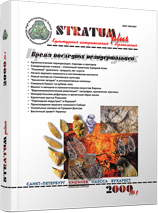Мамонт и женщина в палеолитическом искусстве Европы
Mammoth and Woman in the Palaeolithic Art of Europe
Author(s): Zoya A. AbramovaSubject(s): History, Archaeology, Cultural history, Visual Arts, Gender history
Published by: Издательский дом Stratum, Университет «Высшая антропологическая школа»
Keywords: Mammoth; Palaeolithic Art; female image;
Summary/Abstract: As it was indicated by S. N. Zamyatnin, works of art could have significant meaning for separation of local differences in Upper Palaeolithic of Europe, which are widely represented both in cultural layers of settlements and the walls of the shelter and grotto. Due to the separation, geographical and chronological distribution of two most imposing and valuable in biological and social sense objects of Palaeolithic art are considered mammoth and woman. This allows to show a significant difference between them in space and time. The female image in mobile art is represented on Iberian and Apennine Peninsulas, where there is no image of mammoth at all. Within near-glacier zone in the Upper Palaeolithic period, these objects are quite rare; in the Middle period, they are widely spread, especially in Central and Eastern Europe; at some Czech and Russian sites, realistic sculptures of mammoths and women are found together; in later period, these objects are absent in Central and Eastern Europe, but common in Western Europe, where joint co-spreading of gravings at stone plates could be mentioned. Pictures of mammoths and woman are fully absent in rock art in Mediterranean region and could be met only in Cantabrian and France. An image of mammoth is commonly accompanied by female symbolic images: vulvae and claviforme, existing from early stages up to the Upper Palaeolithic. Chronological separation of rock art is awkward, however it is possible to say that the image of mammoth, appearing early, gets more distribution in the Magdalenian. A special style of Ardeche is singled out, belonging probably to the Solutrean. Associations with female realistic image are rare and took place at different times. At present time all these facts could not be properly interpreted, but hopefully, continuation of other associations analysis will help to determine certain natural development of Palaeolithic art.
Journal: Stratum plus. Археология и культурная антропология
- Issue Year: 2000
- Issue No: 1
- Page Range: 319-325
- Page Count: 7
- Language: Russian
- Content File-PDF

